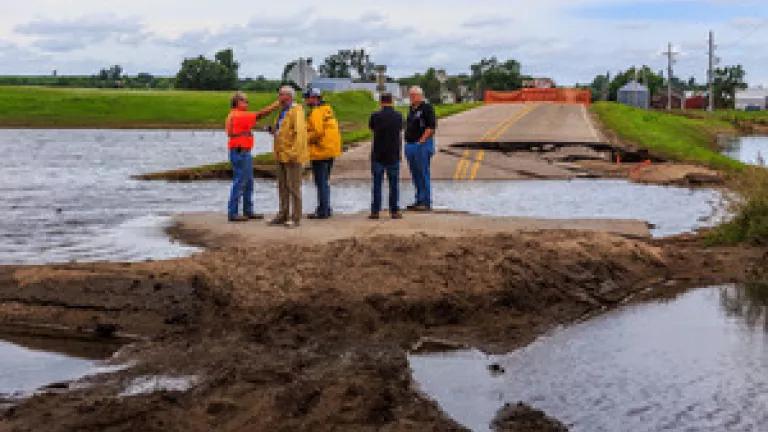
On Tuesday my NRDC colleague Joel Scata will be travelling to Ames, Iowa for a public meeting on new flood protection standards that are being implemented for all federal government agencies. The new standards were set forth in an executive order signed by President Obama on January 30th and are much needed.
The new standard is a big improvement and gives federal agencies the flexibility of selecting one of three benchmarks when evaluating project designs or deciding whether to fund public infrastructure projects:
n for critical projects; or
In addition, the standard places a new emphasis on simply building outside the floodplain whenever practical and not relying so heavily on levees and floodwalls. Instead the new standard emphasizes the use of natural flood buffers, restoring floodplains, and strategies that give flood waters room to spread out.
Four public meetings are scheduled on the updated flood protection standards and the first will take place in Ames next week. The City of Ames and the State of Iowa are no strangers to flooding, so it's apropos that the first public meeting will be there. Since 1993 Ames has seen major floods in 1993, 1996, 2007, 2008, and 2010 and has experienced serious flash flooding on other occasions. Statewide, Iowa has had a whopping 36 Presidential Disasters declared for floods since 1953. Iowa experiences on average $956 million in damages each year from floods. Two of the biggest floods the state's ever experienced, in 1993 and 2008, caused a combined $15.4 billion in damages.
And the risk of flooding in Iowa -- and states throughout the Midwest -- is projected to increase in response to climate change. A study of how climate will affect flood risk commissioned by FEMA found that the majority of counties in Iowa should expect between a 30% and 60% increase in the size of the 100-year floodplain by 2100. Other parts of the Midwest, particularly around the Great Lakes, could see the 100-year floodplain increase in size by up to 90%.
A flooding study published this month in Nature Climate Change by researchers from University of Iowa found that the frequency of floods in Iowa and across the Midwest is already on the rise. The study examined data from hundreds of stream monitoring stations throughout the Midwest. Just over one-third of the stations showed a marked increase in the frequency of flooding. Fewer than one in ten of the stations showed decreasing trends. The study found that floods were becoming more frequent in a band stretching from North Dakota south to Iowa and Missouri and through Illinois, Indiana and Ohio. The area around Chicago and much of Indiana were also found to be experiencing larger floods, in addition to more frequent floods.
So it's not hard to understand why it's necessary to update the nation's flood protection standards. There is ample scientific evidence that the risk of flooding is already on the rise along along the rivers of the Midwest. And the future projections indicate the problem of flooding will get even worse.
For years it had been assumed that the appropriate level of protection was the elevation of the 100-year flood (a flood that is presumed to have a 1% chance of occurring in any given year). But the so-called "100-year flood" is more likely than we previously thought. And floods will become even more likely as the climate changes, causing precipitation patterns to change as well. It's sheer folly for federal agencies to build something in the floodplain to the elevation of a 100-year flood. Doing so only puts infrastructure at risk and requires taxpayers to pick up the tab for costly post-flood repairs.
The new standards will require federal agencies to use a more conservative estimate of flood risk when they're making decisions about what to build, where to build, and what local and state projects receive federal funding. This is exactly the right decision. We know flood risks are rising in response to climate change and it's high time we help communities prepare for this new reality.
For more information
Association of State Floodplain Managers: Flood Protection Standards Resources
NOAA: Flood Loss Data

